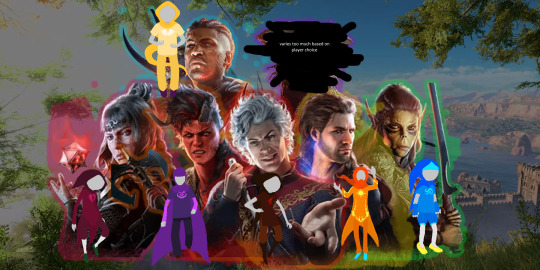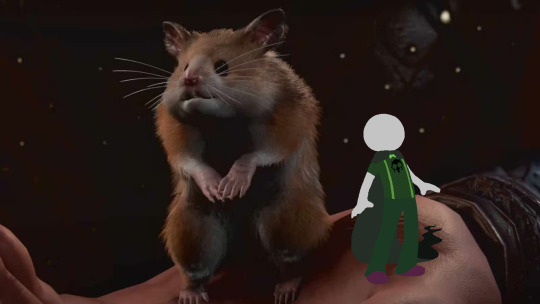#Lae’zel is part of a revolution
Text
WHY ARE ALL OF THE COMPANIONS LIKE THAT
#within the span of a couple hours#Gale wants to blow himself up now#Lae’zel is part of a revolution#Karlach gently pulled me aside and was like oh hey I might be dying#shadowheart is remembering traumatic things!!!#and astarion is watching all this shit go down while laughing#there’s nothing wrong with wyll he already had his moment#Lynx plays bg3#bg3
15 notes
·
View notes
Text



I should post this here too, shouldn't I?
Explanations under the cut
Astarion: Thief of Blood. Along with the obvious fact that he steals literal blood, his initial plan is to manipulate the player into liking him, “stealing” a bond with them for his protection. And that was basically his m.o. for 200 years. If he Ascends, he would turn into a Lord of Blood
Shadowheart: Maid of Heart. I imagine that she’s spent most of her life inverted as a Bard of Mind, allowing her mind to be destroyed by the Sharrans. The Maid of Heart is, well, made of their own identity. It’s a creation class, and Shart is spending the rest of her life creating herself. If she became a Dark Justiciar, she would remain a Bard of Mind
Gale: Mage of Light. The active understanding class and the knowledge aspect fit the resident nerd of the group, don’t you think? He’s probably the smartest party member (in terms of academic/theoretic knowledge) and uses that knowledge to power his magic. In addition, Light is associated with relevancy and acknowledgement and boy oh boy was he desperate for Mystra’s. If he becomes the God of Ambition, he would turn into a Lord of Light
Lae’zel: Prince of Breath. I know the general understanding of Prince is that they destroy the aspect, but I understand them as also being able to destroy through use of their aspect. Lae’zel is destroying Vlaakith’s empire by freeing the githyanki people and leading a revolution. Maybe a bit of a stretch, but I was trying to avoid overlap for the origin characters. I could also see her as a Knight or Prince of Blood
Karlach: Knight of Rage. She’s a berserker, she fights by utilizing rage. And the popular idea that Knights start out lacking in their aspect is pretty apt too, she’s an extremely positive person while Rage is all about more negative emotions. I think she might ghost her inverted class- Rogue of Hope- but never fully inverts, just toys with distributing hope and positivity.
Wyll: Heir of Hope. I fully admit Wyll kinda got the short end of the stick as he was the last character I did, but I do think it fits. Heirs passively manipulate or inspire their aspect in others, and Wyll fights for the people as the Blade of Frontiers, inspiring Hope in those he protects. I could also see him as a Blood aspect, as so much of his story deals with his bonds- to his father, Mizora, Baldur’s Gate and the people of the Coast
Minthara: Maid of Doom. This is where I stopped caring about overlap lol. Minthara is your most “evil” companion and one who approves of killing people in your way. Doom was a pretty clear choice for her, being the Aspect of death, but also dealing with systems and authority, like the Cult of the Absolute and her place in its hierarchy. As for her class, Maids create their aspect and make it a core part of themselves. Minthara has been surrounded by death and hierarchies her whole life, having been born to a high ranking noble house in Menzoberranzan, leading to them being a very core part of her being. I can also see her vacillating wildly between Maid of Doom and her inverse, Bard of Life, because she’s just that chaotic. They both deal with death, but the Bard is a bit more passive about it, allowing others (the Cult, the player) to take lead on the killing
Halsin: Knight of Breath. Again running with the “Knights lack their Aspect” theory, Halsin starts the game lacking the freedom he desires. He’s literally imprisoned by the goblins, but he’s also constrained by his role as Archdruid, almost toying with his inverse of Rogue of Blood. He craves the freedom of nature and jumps at the opportunity to gain it. You could also argue wildshape is a form of freedom (both of form and of self) that he uses to fight. There’s also his talk of polyamory and how he doesn’t want to be tied down. Freedom is a recurring thing with the guy
Jaheira: Witch of Life. Life is a pretty clear choice for a druid, as Life deals with flora and fauna. Witch is the active manipulation class, and Jaheira is introduced manipulating plants to hold the player. Additionally, she’s shown nurturing life by caring for various children in Baldur’s Gate, sorta like how Feferi took care of various marine animals
Minsc: Knight of Hope. Okay this was the hardest one for me because I don’t fully get Minsc. I’ve only played BG3, I don’t know him from any other games or comics or whatever. But from what I do know, he was obviously one of the more offensive and active classes and Knight seems to fit him best. He utilizes Hope- usually in the form of others’ trust in him- to fight. Without that trust, he wouldn’t be as effective, he always fights best with his companions. He’s also just a happy, up-beat guy, and Hope is largely focused on positive emotions
Boo: Lord of Doom. BOO DECIDES THE FATE OF ALL. HE HAS ULTIMATE SAY OVER LIFE AND DEATH
#Baldur's Gate 3#BG3#Baldurs Gate 3#Baldur's Gate#Baldurs Gate#Homestuck#No i'm not sorry for doing this#Astarion#Shadowheart#Gale#Lae'zel#Karlach#Wyll Ravenguard#Minthara#Halsin#Jaheira#Minsc
112 notes
·
View notes
Text
I have more to say about how I feel about the ending of BG3 after beating it as both an evil Bhaalspawn and a redeemed hero. End game spoilers under the cut.
I don’t like what I feel like the game is saying about the ultimate reward for being a good person, at least from my perspective after playing through twice. In my evil game Calio had virtually no allies, he’d caused the deaths of almost all his companions and the ones he still had were either on their own paths to being villains or miserable. Then he took control of the Netherbrain, betrayed the last few people who actually trusted him and handed the world to Bhaal on a silver platter. The final scene is him on a throne of bone surrounded by his mind-controlled ‘friends’ while he uses godlike power to wipe out some attacking Githyanki. He gets everything he wanted, essentially. Power and no one being able to stop him as he razes the universe to the ground in his god’s name. He is happy in his absolutely twisted way as the world burns.
Then we have Adramelek, who fought against the monster within himself and won. He denied Bhaal and was given a second chance at life as his own person. He helped all of his friends to become their best selves. He fought tooth and nail to save not just this city or this world but even the Githyanki and anyone else he came across who he could lend help to.
And what does he get in the end? He has no choice but to sacrifice himself and turn into a mindflayer, otherwise he’d have to damn the Githyanki to their slavery at Vlaakith’s hands by either letting the Emperor kill Orpheus or by letting Orpheus make the ultimate sacrifice for his people and become a mindflayer himself. Addy couldn’t betray Lae’Zel’s trust like that, not after he’d spent so long promising her that he would help to save her people.
So in the end the city is saved, everyone is celebrating, it’s a beautiful happy moment. All of Addy’s friends survived. Karlach and Wyll have a lead for fix for her heart. Lae’Zel is fighting a revolution alongside Orpheus, and has learned and grown so much at Addy’s side that she can even be Orpheus’ diplomat. Shadowheart is traveling and finding herself for the first time in her life. Gale is teaching students the ways of the Weave and is finally free from the mistakes of his past. And while Astarion had to return to the shadows, he’s learned to accept himself as he is, and is actually genuinely happy despite his lot in life. The world at large is so much better than it was before Addy touched it.
And yet Adramelek is a mindflayer, losing what is left of himself, seeing his once beloved friends as ‘valuable assets’, having to fight against himself to not try to eat their brains. Astarion doesn’t know how much of the man he loved is even in there anymore, and they parted ways, deciding to just be friends while they figured out this new situation. So Addy lost the most loving and dear relationship to him he had, and he doesn’t even remember how to properly feel sad about it.
The world is happy, at peace, and on its way to healing. But the one who saved it is damned.
So what do these two stories tell us? That doing the right thing will destroy you and make you miserable even as those around you are lifted up, and that being a terrible person will get you everything you want so long as you don’t mind destroying everything and everyone around you? That’s so fucking cynical. I hate it. It leaves such a sour taste in my mouth.
#bg3#bg3 spoilers#baldur's gate 3#I love this game to death don’t get me wrong#I just…am really bitter about what it has to say in the end#I worked hard to make Adramelek good and to try to get a happy ending with him and Astarion.#I defeated Orin three times to get the game to finally acknowledge I beat her and was still alive after#so that I could get the denying Bhaal scene.#I don’t think I would have even bothered if I’d known#Addy was just going to become a mindflayer in the end anyways and lose his mind regardless.
4 notes
·
View notes